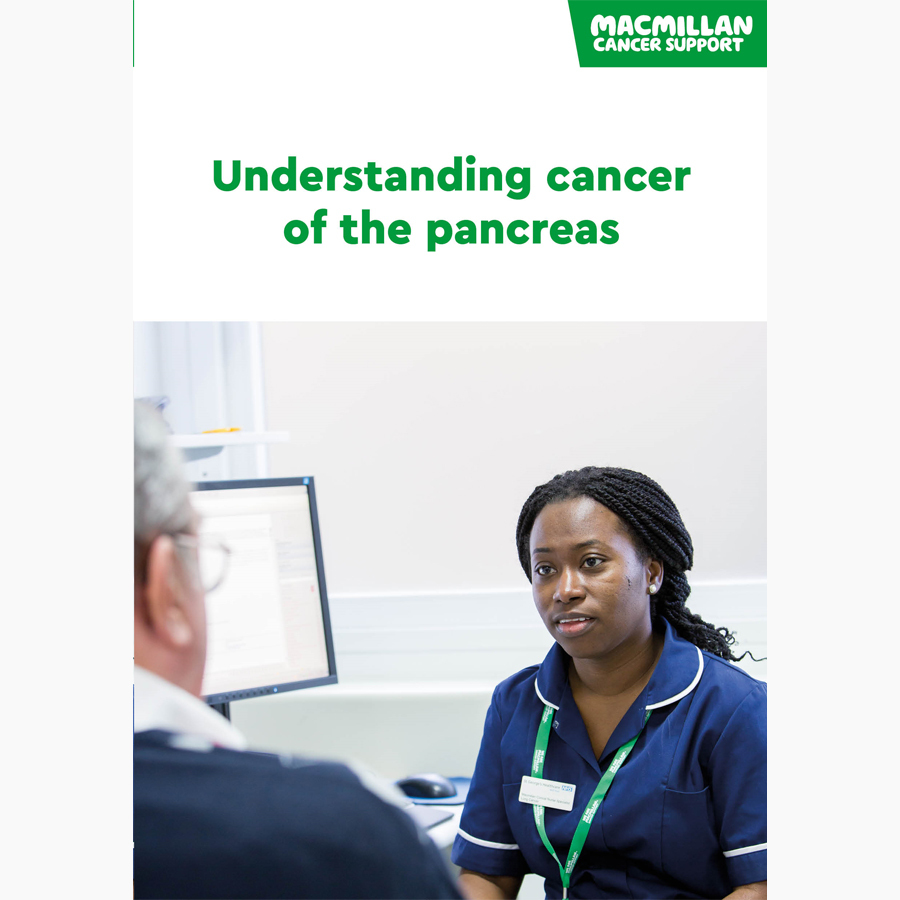Pancreatic cancer
On this page
-
What is pancreatic cancer?
-
Symptoms of pancreatic cancer
-
Causes and risk factors of pancreatic cancer
-
Tests and diagnosis of pancreatic cancer
-
Staging and grading of pancreatic cancer
-
Treatment for pancreatic cancer
-
Coping with advanced cancer
-
After pancreatic cancer treatment
-
About our information
-
How we can help
What is pancreatic cancer?
Pancreatic cancer is a cancer that starts in the pancreas. The pancreas is part of the digestive system. The pancreas makes digestive juices called enzymes. It also makes hormones including insulin.
About 10,500 people are diagnosed with pancreatic cancer in the UK each year.
View the video without BSL interpreter on our YouTube Channel.
Booklets and resources
Types of pancreatic cancer
There are several different types of pancreatic cancer. Pancreatic cancer types are described based on:
- where it is in the pancreas – 6 out of 10 pancreatic cancers start in the head of the pancreas
- the type of cell they start from.
This information is about the most common types of pancreatic cancer. These start in exocrine cells, which make pancreatic juices. We have information about cancers which sometimes start in the pancreas:
Related pages
Symptoms of pancreatic cancer
Pancreatic cancer may not cause symptoms for a long time. Some people may only have one symptom.
Some possible symptoms are:
- pain and discomfort in the upper part of the tummy (abdomen) that sometimes spreads out into the back
- signs of jaundice such as yellowing of the skin and the whites of the eyes, itchy skin, dark pee (urine) or pale and smelly poo (stools) that are difficult to flush away (steatorrhoea)
- unexplained weight loss.
Most people with these symptoms will not have pancreatic cancer. They may be caused by other more common conditions. But if you have any symptoms, it is important to get them checked by your doctor.
We have more detailed information about pancreatic cancer symptoms.
Related pages
Causes and risk factors of pancreatic cancer
Doctors do not know what causes pancreatic cancer. But things called risk factors can increase the chance of a person developing it. For example, being older is a risk factor. Most people who develop pancreatic cancer are 65 or over.
Some other risk factors include:
- smoking or using tobacco
- drinking a lot of alcohol regularly
- having had a previous cancer.
We have more information about the causes and risk factors of pancreatic cancer.
Tests and diagnosis of pancreatic cancer
If you have symptoms, you usually begin by seeing your GP. If your GP thinks cancer could be causing your symptoms, they will refer you to hospital. If you are aged 60 or older, they may refer you urgently. They may arrange a CT scan or ultrasound scan within 2 weeks. They may arrange an urgent CT scan or ultrasound within 2 weeks. If you are 40 or older and have jaundice, you should see a specialist within 2 weeks.
Some people are diagnosed with pancreatic cancer after being admitted to hospital because a symptom is making them unwell.
At hospital you will have tests and get specialist advice and treatment. To diagnose pancreatic cancer, doctors often use information from several tests, along with your symptoms and medical history.
If you are diagnosed with pancreatic cancer, you may need more tests. These are to find out the size and position of the cancer. They will also let doctors know whether it has spread to other parts of the body.
You may have some of the following tests.
Blood tests
General blood tests
You will have blood tests to check your general health and how well your liver and kidneys are working.Tumour markers
You may have blood tests to check for tumour markers. These are chemicals that many pancreatic tumours produce.Other tests
-
Ultrasound scan
An ultrasound uses sound waves to make a picture of internal organs, like the pancreas and liver.
-
CT scan
A CT scan takes a series of x-rays, which build up a 3D picture of the inside of the body.
-
MRI scan
An MRI scan uses magnetism to build up a detailed picture of the inside of the body.
-
Magnetic resonance cholangio-pancreatography (MRCP)
An MRCP uses magnetic and radio waves to get a detailed picture of your pancreas, bile ducts and liver. It is a type of MRI scan, but it is not available in every hospital. The scan shows any narrowing or blockages in the pancreatic ducts or bile ducts.
-
Endoscopic ultrasound (EUS)
An endoscopic ultrasound is when they use a thin flexible tube (endoscope) to look down into your stomach at the pancreas and other organs. It can be used to take samples of tissue (biopsy) or see how far the cancer has spread.
-
Endoscopic retrograde cholangio-pancreatography (ERCP)
An ERCP is when they pass a thin flexible tube (endoscope) down into the first part of the small bowel (duodenum). They look at the pancreas and take samples of tissue (biopsies).
-
PET-CT scan
PET-CT scans give more detailed information about the part of the body being scanned.
Biopsy
Your doctor may want to remove a small piece of tissue from the area (biopsy). They look at the sample under a microscope to check for cancer cells. There are different ways of doing a biopsy.
Not everyone needs a biopsy. Your doctor will explain if it would be helpful in your situation.
Surgery to look inside the tummy
If other tests have not confirmed a diagnosis, you may have a small operation to look inside the tummy at the pancreas. This is called a laparoscopy.
The surgeon puts a thin tube called a laparoscope through a small cut they make in your tummy. You have this done under a general anaesthetic.
Rarely, if a laparoscopy is not suitable, you may have a bigger operation called a laparotomy instead. This is when the surgeon makes a larger cut in the tummy so they can see the pancreas.
Related pages
Staging and grading of pancreatic cancer
The results of your tests help your doctors find out more about the size and position of the cancer and whether it has spread. This is called staging.
A doctor decides the grade of the cancer by how the cancer cells look under the microscope. This gives an idea of how quickly the cancer may develop and grow.
Knowing the stage and grade of pancreatic cancer helps doctors decide the best treatment for you.
Treatment for pancreatic cancer
A team of specialists will meet to discuss the best possible treatment for you. This is called a multidisciplinary team (MDT).
Your cancer doctor or specialist nurse will explain the different treatments and their side effects. They will also talk to you about certain things to think about when making treatment decisions.
We have more information about how different treatments are used for pancreatic cancer.
Treatment for pancreatic cancer may include:
-
Surgery
If you have an early stage of pancreatic cancer, you may have surgery to remove all or part of the pancreas. Surgery may also be used to relieve relieve symptoms.
-
Chemotherapy
Chemotherapy uses anti-cancer (cytotoxic) drugs to destroy cancer cells. It is one of the most commonly used treatments for pancreatic cancer.
You may have it after surgery to reduce the chance of the cancer coming back (adjuvant chemotherapy).
You may have it to control the cancer or relieve symptoms.
Some people have chemotherapy before surgery to help shrink the cancer (neo-adjuvant chemotherapy). -
Treatment for symptoms
For many people with pancreatic cancer, the main aim of treatment is to control symptoms. You can also have treatments that will help you feel better and have the best quality of life possible. This is called supportive care.
-
Radiotherapy
Radiotherapy uses high-energy rays to destroy cancer cells. It is not often used to treat pancreatic cancer. It may be given with chemotherapy (chemoradiation) to shrink a cancer before surgery. It can also be given if the cancer has just started to spread but surgery isn’t possible. It is also used to manage symptoms such as pain.
Research is going on to find more effective treatments for pancreatic cancer.
You may have some treatments as part of a clinical trial. Or you may be invited to take part in a trial of a new drug or treatment.
Coping with advanced cancer
For many people with pancreatic cancer, it will not be possible to cure pancreatic cancer.
Chemotherapy and radiotherapy can sometimes help shrink the cancer for a time. This can help to control symptoms. You can also have other treatments that will help you feel better and have the best quality of life possible.
This is called supportive care. Making sure you have the best quality of life possible is an important part of your treatment and care.
Finding out you have advanced cancer can be difficult to cope with. You may feel shocked and find it hard to understand or accept. You may have questions about what to expect. Your doctor and specialist nurse are there to help.
We have more information about coping with advanced cancer.
After pancreatic cancer treatment
After your treatment, you will have regular follow-up appointments. You will also have follow-up appointments if you are having supportive care. You may keep going to the hospital for these appointments, or you may go to your GP. Sharing the appointments between the GP and hospital is sometimes called a shared care agreement.
You may continue to have regular scans and blood tests, including CA 19-9 tests. Tell your doctor or specialist nurse as soon as possible if you have any problems or new symptoms between appointments.
You may get anxious between appointments. This is natural. It may help to get support from family, friends or a support organisation such as Pancreatic Cancer UK.
Macmillan is also here to support you. If you would like to talk, you can:
- Call the Macmillan Support Line on 0808 808 00 00.
- Chat to our specialists online.
- Visit our pancreatic cancer forum to talk with people who have been affected by pancreatic cancer, share your experience, and ask an expert your questions.
Related pages
About our information
-
References
Below is a sample of the sources used in our pancreatic cancer information. If you would like more information about the sources we use, please contact us at cancerinformationteam@macmillan.org.uk
European Society for Medical Oncology, Cancer of the pancreas: ESMO clinical Practice Guidelines. Volume 26, Supplement 5, V56-V68, 1 September 2015. Available from: https://doi.org/10.1093/annonc/mdv295 (accessed May 2021).
National Institute for Health and Care Excellence. Pancreatic cancer in adults: diagnosis and management. NICE guideline (NG85). Published 7 February 2018. Available at: https://www.nice.org.uk/guidance/ng85/chapter/Recommendations (accessed May 2021).
-
Reviewers
This information has been written, revised and edited by Macmillan Cancer Support’s Cancer Information Development team. It has been reviewed by expert medical and health professionals and people living with cancer. It has been approved by Chief Medical Editor, Professor Tim Iveson, Consultant Medical Oncologist.
Our cancer information has been awarded the PIF TICK. Created by the Patient Information Forum, this quality mark shows we meet PIF’s 10 criteria for trustworthy health information.
Date reviewed
This content is currently being reviewed. New information will be coming soon.

Our cancer information meets the PIF TICK quality mark.
This means it is easy to use, up-to-date and based on the latest evidence. Learn more about how we produce our information.




